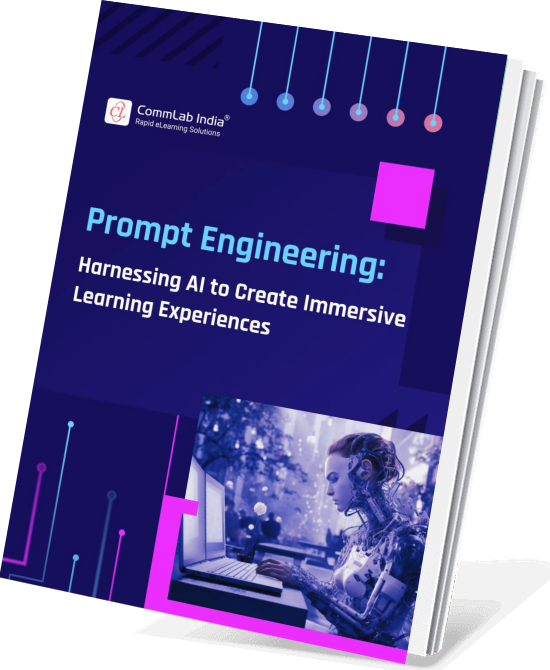AI and L&D: Training Manager’s Guide to Understanding this Powerful Alliance

The learning and development (L&D) industry has transformed in remarkable ways.
In today’s fast-changing corporate world, innovation and adaptation are paramount. With that said, the role of training managers has never been more crucial. So, in this blog, we’ll explore the synergy between artificial intelligence (AI) and learning and development (L&D). Apart from that, we’ll also try to understand how training managers can leverage this powerful duo to lead their teams.
→ Download eBook: Prompt Engineering for L&D Professionals!
Let’s dive in!
- How is the L&D Landscape Changing?
- How is Artificial Intelligence (AI) Transforming L&D?
- How to Implement AI in Your L&D Strategy?
- What Training Managers Can Look Forward to?
How is the L&D Landscape Changing?
In our L&D industry, we realize that the traditional approaches to learning and development (L&D) often fall short in addressing the dynamic learning needs of the modern-day workforce because the skills and knowledge become outdated quickly. That’s right! Learners these days need continuous upskilling and reskilling. And to ensure that, there needs to be a paradigm shift in L&D strategies. It’s time to cherish more personalized, adaptive, and agile learning approaches. Approaches that cater to their unique learning needs of diverse, global workforce and align with organizational goals.
How is Artificial Intelligence (AI) Transforming L&D?
When we talk about modern, adaptive, personalized learning approaches, artificial intelligence (AI) takes the center stage. In fact, it is at the forefront of this L&D revolution as it has the potential to analyze vast amounts of data, identify learning patterns, and make data-driven predictions. In the context of L&D, AI can accurately pinpoint skill gaps and training requirements, facilitate interactive content, boost speed, offer knowledge management, promote personalized and adaptive learning, facilitate dynamic skill profiling, and ensure instantaneous feedback. Isn’t it amazing to have an AI-powered system that recommends relevant courses, adapts content based on learning progress, offers learning and trend insights, etc? It sure is! Now let’s see how you can implement AI in your L&D strategy.
How to Implement AI in Your L&D Strategy?
It might seem like one but integrating AI into your L&D strategy doesn’t really have to be a daunting task. All you need to do is start by identifying specific pain points or areas where AI can add value. Based on the results of your analysis, choose AI-powered tools and platforms that align with your training requirements, organization’s needs, and technology infrastructure. With that said, make it a point to regularly assess the impact of AI-powered initiatives and make modifications along the way.
What Training Managers Can Look Forward to?
AI and L&D: A Dream Team for Training Managers!
Here are convincing reasons why:
- Better Learner Engagement
- Personalized and Adaptive Learning
- Streamlined Operations
- Increased Cost-Efficiency
- Reliable Data Analytics
- Improved Evaluation Process
- Enhanced Training ROI
1. Better Learner Engagement
It’s very important for your learners to pay attention and stay engaged in the learning process for effective, desired results. With AI, the task of ensuring learner engagement becomes as easy as ABC. You can leverage various AI-powered platforms such as Pictory, Synthesia, Vyond Go, Filmora, etc., to create amazing, interactive multimedia elements. That’s right! From audio to animations to videos to images, AI tools got you covered.
You can even incorporate eLearning interactivities for promoting learner engagement and attentiveness. Wondering which eLearning interactivities to use? We’ve got you covered on that. Check out the infographic below.

2. Personalized and Adaptive Learning
AI ensures personalized learning as its algorithms can analyze the strengths, weaknesses, learning style, interests, etc., of the learners. AI is being largely leveraged in custom eLearning. Based on this data, it suggests learning courses ensuring that training content remains relevant, and aligned with both individual and organizational goals. Apart from that, it also facilitates adaptive learning based on the performance and progress of the learner. It can quickly understand and adapt to the learner’s pace of learning, their learning preference, etc., and curate the content for maximum efficiency.
3. Streamlined Operations
Streamlined operations in L&D are integral. And AI ensures that different tasks fit together in perfect harmony. You can easily use it to automate various administrative tasks, such as scheduling, reminders, progress tracking, etc.
4. Increased Cost-Efficiency
AI helps you save cost and your precious resources on manual tasks. Instead, it enables you to automate the mundane tasks so you can channel your resources towards creating awe-inspiring, learner-centric L&D courses. Check out the infographic below to know the top elements of designing such effective courses.

These immersive, interactive courses will further help enrich minds and augment productivity and performance.
5. Reliable Data Analytics
AI empowers you with data-driven insights. It is capable of analyzing large amounts of data. These data analytics provide you with actionable insights into learner progress, program effectiveness, areas for improvement, etc. All these elements combined help you in making informed decisions and continuous refinement of L&D strategies.

Prompt Engineering — Harnessing AI to Create Immersive Learning Experiences
Learn the Art of Crafting Effective Prompts and Get Desired Outcomes
- What is Prompt Engineering?
- Why is Prompt Engineering Important?
- How to Craft Effective Prompts?
- And More!
6. Improved Evaluation Process
AI makes the evaluation process more personalized and instant. It offers predictive analysis based on learner performance in various eLearning assessments. The factors considered for evaluating the performance include test scores, experience, time duration, etc.
Using and compiling this real-time data, AI enables instant action and personalized feedback. This helps trainers modify their instructional methods, offer supplementary resources, and provide additional support to ensure that learning outcomes are met more effectively. Check out the video below to know effective ways of giving constructive feedback.
7. Enhanced Training ROI (Return on Investment)
AI It offers us insights based on data analytics that help identify high-impact training initiatives and ensure that resources are allocated efficiently. AI allows you to target specific skill gaps and focus on the most beneficial areas, therefore you can achieve a greater training ROI.
Parting Thoughts!
Leveraging AI in the field of L&D offers a world full of possibilities! That’s right. From adaptive learning to cost-efficiency to better learner engagement, AI is a training manager’s dream come true!! So you, the futuristic and ambitious training managers, have a golden opportunity to lead the charge in designing more effective, immersive, and high-quality learning courses. Here’s an eBook to help you learn the art of crafting effective prompts to be at the forefront of AI innovation in the L&D industry!
Editor's note: This post was originally published on August 15, 2023 and has been updated for comprehensiveness.





